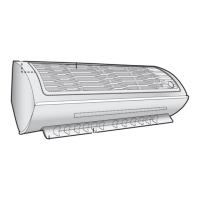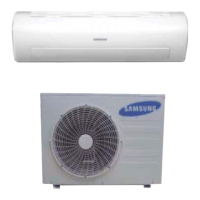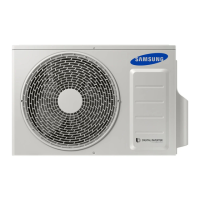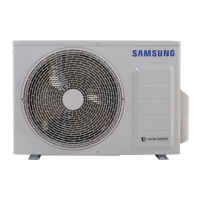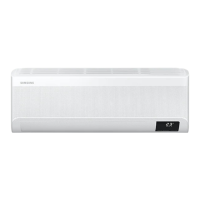Do you have a question about the Samsung AR12HSFSJWKX and is the answer not in the manual?
Explains safety symbols and general operating precautions.
Critical warnings and advice for a safe installation process.
Precautions for safe electrical connections and power supply.
Safety measures for operating, cleaning, and handling the appliance.
Safety instructions for cleaning the indoor and outdoor units.
Specifies recommended temperature and humidity ranges for efficient operation.
Describes internal protections within the unit control system for fault conditions.
Explains the installer's check for correct installation using the Smart Install function.
Illustrates and names the primary physical components of the air conditioner unit.
Details the various indicators and display elements on the remote controller.
Explains the function of each button on the remote controller for operation.
Indicates low battery warning and guides on battery insertion.
Provides instructions on how to store the remote controller when not in use.
Describes the fundamental operating modes: Auto, Cool, Dry, Fan, and Heat.
Guides on adjusting temperature and fan speed for each operating mode.
Details how to control the up and down movement of the air flow blades.
Explains how to control the left and right movement of the air flow blades.
Step-by-step instructions for programming the timer to turn the unit on.
Instructions for programming the timer to turn the unit off automatically.
Explains how to set both On and Off timers for sequential operation.
How to activate and configure the sleep mode settings for comfortable sleep.
How to activate the 2-Step Cooling function for efficient temperature management.
Activates powerful cooling/heating for rapid temperature adjustment.
Provides mild cooling/heating for comfortable, indirect airflow.
Reduces energy consumption by optimizing operation for a single user.
Minimizes operational noise from the indoor unit during cooling or heating.
Produces positive ions to improve air quality by neutralizing pollutants.
Minimizes indoor unit moisture to provide clean air.
Allows muting of operational beep sounds from the indoor unit.
Displays the amount of electricity consumed by the air conditioner during operation.
Resets the reminder after cleaning the air filter.
Adjusts the lighting of the display on the remote controller and indoor unit.
Enables convenient control of the air conditioner via a smartphone app.
Details how to clean the indoor unit, including cautions for display and detergents.
Explains how to clean the outdoor unit's heat exchanger for optimal performance.
Guides on removing, cleaning, and drying the air filter for maintenance.
A chart detailing maintenance tasks and their recommended frequencies for optimal upkeep.
Provides solutions for common problems like the unit not working or temperature adjustment issues.
Solutions for airflow adjustment issues, fan speed, remote control, and timers.
Troubleshooting for odors, error indications, noise, and water dripping.
Covers reading the manual, unit handling, and proper disposal of components.
Specific safety steps and considerations for installing the unit correctly.
Factors for choosing the best indoor unit placement for airflow and access.
Recommendations for outdoor unit placement considering wind, ventilation, and noise.
Details the necessary space around the outdoor unit for ventilation and service.
Details accessories provided for the indoor unit, such as plates and remote controller.
Lists accessories supplied with the outdoor unit, like cables and drain plugs.
Describes optional connection accessories and tools required for installation.
How to determine the correct position for drilling holes for pipes and cables.
Instructions for attaching the installation plate to different wall types.
Guides on removing and refitting the indoor unit's cover panel for installation.
Table listing required wire types, AWG, and cross-sectional area for different models.
Step-by-step instructions for making secure and compliant electrical connections.
Step-by-step process for connecting refrigerant pipes to the indoor unit.
Instructions for properly cutting and extending refrigerant pipes, including tool usage.
Details how to route the drain hose correctly, ensuring no upward slant or bends.
Instructions for altering the drain hose connection direction if necessary.
How to connect the drain hose to the outdoor unit and ensure proper drainage.
Process for removing air from refrigerant pipes and the system before operation.
Instructions on how to add refrigerant based on pipe length and model specifications.
Explains the process of charging refrigerant using a liquid pipe, including cylinder handling.
Methods to test for refrigerant leaks on indoor and outdoor units.
Steps for collecting system refrigerant in the outdoor unit before disconnection.
Steps for mounting the indoor unit onto the installation plate and securing it.
Guidelines for installing the outdoor unit on a stable base, considering wind and vibration.
How to initiate the Smart Install mode to check system installation status.
Explains mode progress, success, and troubleshooting for error codes.
Verifying installation strength, pipe tightness, wiring, drainage, and grounding.
How to start and test the unit in Cool or Heat mode after installation.
Steps for pump down when removing the product, ensuring refrigerant recovery.
Detailed instructions for safely extending the power wiring using connection sleeves and contraction tubes.
Guides on installing an optional Sub PCB for enhanced control capabilities.
Details components and wiring connections for installing a wired remote controller.
Highlights the importance of proper installation for meeting ENERGY STAR criteria and optimal performance.
Explains safety symbols and general operating precautions.
Critical warnings and advice for a safe installation process.
Precautions for safe electrical connections and power supply.
Safety measures for operating, cleaning, and handling the appliance.
Safety instructions for cleaning the indoor and outdoor units.
Specifies recommended temperature and humidity ranges for efficient operation.
Describes internal protections within the unit control system for fault conditions.
Explains the installer's check for correct installation using the Smart Install function.
Illustrates and names the primary physical components of the air conditioner unit.
Details the various indicators and display elements on the remote controller.
Explains the function of each button on the remote controller for operation.
Indicates low battery warning and guides on battery insertion.
Provides instructions on how to store the remote controller when not in use.
Describes the fundamental operating modes: Auto, Cool, Dry, Fan, and Heat.
Guides on adjusting temperature and fan speed for each operating mode.
Details how to control the up and down movement of the air flow blades.
Explains how to control the left and right movement of the air flow blades.
Step-by-step instructions for programming the timer to turn the unit on.
Instructions for programming the timer to turn the unit off automatically.
Explains how to set both On and Off timers for sequential operation.
How to activate and configure the sleep mode settings for comfortable sleep.
How to activate the 2-Step Cooling function for efficient temperature management.
Activates powerful cooling/heating for rapid temperature adjustment.
Provides mild cooling/heating for comfortable, indirect airflow.
Reduces energy consumption by optimizing operation for a single user.
Minimizes operational noise from the indoor unit during cooling or heating.
Produces positive ions to improve air quality by neutralizing pollutants.
Minimizes indoor unit moisture to provide clean air.
Allows muting of operational beep sounds from the indoor unit.
Displays the amount of electricity consumed by the air conditioner during operation.
Resets the reminder after cleaning the air filter.
Adjusts the lighting of the display on the remote controller and indoor unit.
Enables convenient control of the air conditioner via a smartphone app.
Details how to clean the indoor unit, including cautions for display and detergents.
Explains how to clean the outdoor unit's heat exchanger for optimal performance.
Guides on removing, cleaning, and drying the air filter for maintenance.
A chart detailing maintenance tasks and their recommended frequencies for optimal upkeep.
Provides solutions for common problems like the unit not working or temperature adjustment issues.
Solutions for airflow adjustment issues, fan speed, remote control, and timers.
Troubleshooting for odors, error indications, noise, and water dripping.
Covers reading the manual, unit handling, and proper disposal of components.
Specific safety steps and considerations for installing the unit correctly.
Factors for choosing the best indoor unit placement for airflow and access.
Recommendations for outdoor unit placement considering wind, ventilation, and noise.
Details the necessary space around the outdoor unit for ventilation and service.
Details accessories provided for the indoor unit, such as plates and remote controller.
Lists accessories supplied with the outdoor unit, like cables and drain plugs.
Describes optional connection accessories and tools required for installation.
How to determine the correct position for drilling holes for pipes and cables.
Instructions for attaching the installation plate to different wall types.
Guides on removing and refitting the indoor unit's cover panel for installation.
Table listing required wire types, AWG, and cross-sectional area for different models.
Step-by-step instructions for making secure and compliant electrical connections.
Step-by-step process for connecting refrigerant pipes to the indoor unit.
Instructions for properly cutting and extending refrigerant pipes, including tool usage.
Details how to route the drain hose correctly, ensuring no upward slant or bends.
Instructions for altering the drain hose connection direction if necessary.
How to connect the drain hose to the outdoor unit and ensure proper drainage.
Process for removing air from refrigerant pipes and the system before operation.
Instructions on how to add refrigerant based on pipe length and model specifications.
Explains the process of charging refrigerant using a liquid pipe, including cylinder handling.
Methods to test for refrigerant leaks on indoor and outdoor units.
Steps for collecting system refrigerant in the outdoor unit before disconnection.
Steps for mounting the indoor unit onto the installation plate and securing it.
Guidelines for installing the outdoor unit on a stable base, considering wind and vibration.
How to initiate the Smart Install mode to check system installation status.
Explains mode progress, success, and troubleshooting for error codes.
Verifying installation strength, pipe tightness, wiring, drainage, and grounding.
How to start and test the unit in Cool or Heat mode after installation.
Steps for pump down when removing the product, ensuring refrigerant recovery.
Detailed instructions for safely extending the power wiring using connection sleeves and contraction tubes.
Guides on installing an optional Sub PCB for enhanced control capabilities.
Details components and wiring connections for installing a wired remote controller.
Highlights the importance of proper installation for meeting ENERGY STAR criteria and optimal performance.
| Brand | Samsung |
|---|---|
| Model | AR12HSFSJWKX |
| Category | Air Conditioner |
| Language | English |



